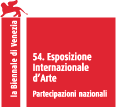Statement
In his Venice project, Markus Schinwald examines the Austrian Pavilion built 1934 by Josef Hoffmann, an architectural landmark in and around the Giardini district.
Markus Schinwald, who scored success with complex installations he realized mainly in museums and art institutions outside Austria, as for example in Zurich, Frankfurt, Brussels, and Budapest, has a comprehensive oeuvre to show for, with his works combining performative with painterly, sculptural, filmic and architectural elements.
With subtlety and finesse, Schinwald explores dispositifs of control, disciplining, and self-improvement, which inscribe themselves in the human body, shaping and pervading it to re-emerge on the body surface as psychologically charged inner worlds, visible and palpable.
This approach also makes itself felt in his Biennale contribution: the viewer turns into a performer, the pavilion into a closed stage. By dissecting the interior space along vertical axes, a new mode of perception emerges which makes the human body its structural frame of reference: “Although these constructional components are of course architectural elements, it suggested itself to use psychoanalytical terms for a concise definition; after all, the space created is dissociative rather than
than actually fragmented: claustrophobic above and nothing below. Or, if you will, the mind in neurosis, the crotch in psychosis. However, unlike in the spatial sculptures of Bruce Nauman or Robert Morris, the space intervention is not an autonomous act here, but also a kind of stage system or environment for the display of different works. It is, for one thing, an attempt to establish various different elements and, at the same time, to avoid explicit categorizations through contrastive positioning”, Markus Schinwald explains.
In the context of the general theme of ILLUMInations as defined by Bice Curiger, Markus Schinwald negotiates the representation and manipulation of space, time, light and shadow. Not only does he transform the spatial experience through an element of disturbance between the visible and the concealed, but also leaves, and addresses, the pavilion’s architecture and history as it is, with all its breaches, rifts, and blanks, and thus succeeds to give sociopolitical visibility to the inscrutable. Both in his architectural interventions and in his performances, films, and reworkings of 19th century paintings and lithographs, disturbance and distraction are constituent elements used to alter perception.
In the center of his artistic examination are the psychological exploration of space and body, eeriness and discomfort, the defective and the irrational depths of individual and collective existence. Schinwald focuses his observing gaze on the human body with all its deficiencies and on the sociocultural environment it is embedded in. Being involved by the artist in the spatial and temporal framework, the detached passive viewer becomes a protagonist, an active watcher who is given an opportunity to develop and pursue his or her own analogies and narrative strands.
To contribute to the discussion about big media events such as the Venice Biennale, new interviews with internationally renowned artists, museum directors, curators, architects, critics, collectors, and gallerists will be posted every two weeks at the website www.labiennale.at. Initiated by Eva Schlegel, this video platform is entitled “Approaching Venice” and critically interrogates the history of the Biennale di Venezia from different perspectives.
